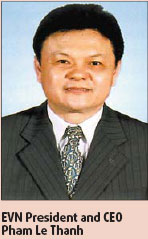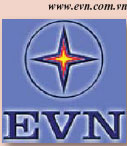EVN seeks more capital to meet booming power demand
Vietnam Electricity (EVN) has achieved rapid growth in recent years.
The state-owned corporation is engaged in generating, transmitting, distributing and selling electric power.
In 2005, EVN's revenue from power sales reached $2.48 billion, with a profit of $195.67 million. With this kind of growth, the total assets of the company has topped $7.08 billion.
Between 2000 and 2005, EVN achieved a remarkable goal by meeting the power demands of this rapidly developing country that has seen an annual growth rate of 14 percent.
Dynamic development
The demand for power is escalating in Vietnam.
It is estimated that by 2010 Vietnam will produce 117-124 billion kilowatt hours (kWh) of energy, with the peak capacity of 19,900-21,000 megawatts (MW), and the estimates grow larger in future years: 334-429 billion kWh in 2020.
By 2010, not only will 95 percent of households be connected to the grid, but also EVN will need 14,000 MW of new generation - an additional 2,800 MW every year.
To realize the objectives set forth in the 2006-2015 Master Plan for Power Development (with perspective to 2025), EVN will need roughly $3.5-4 billion in investment capital through 2010.
In addition to traditional fund-raising channels, EVN currently has embarked on a new fund mobilization task: bond issuance.
The demand for investment keeps increasing while the diversification of investment forms for power generation cannot catch up.
Privatization
In line with the Prime Minister Nguyen Tan Dung and Ministry of Industry's decision on the equitization of EVN's subsidiaries, EVN has started privatizing its member companies.
Currently, 21 of them have successfully been transformed into joint stock companies.
In 2007, EVN Group is using a new organizational model and is rapidly diversifying.
Apart from production and sales of electricity, EVN's other core businesses include public telecommunication, electro-mechanical manufacturing, and banking.
EVN employs some 80,000 people, 50,000 of whom are working in the power and telecommunication divisions.
Diversification
EVN Telecom has become a familiar and trusted name among customers.
As forecasted, about 50 million Vietnamese will subscribe to telecommunication services in 2010. This is an opportunity as well as a challenge in a competitive market.
"We deeply understand that only good quality, competitive pricing, and new diversified services can build the trust from customers," EVN President and CEO Pham Le Thanh, said.
"We are now speeding up the construction of the telecommunication infrastructure in order to provide customers with the best possible services and competitive prices, striving for the target of serving two million customers by 2007 and 10 million by 2010."
Growing cooperation
A decade ago, there was little cooperation between China and Vietnam in the energy sector.
In the last five years, however, that has changed. EVN is now importing energy from Hunan Province in Central China and working in partnership with China Southern Grid (CSG).
"We are negotiating a large-scale energy exchange project in China after 2010," Thanh said.
"The interconnecting 500 kilo-voltages (kV) line between Hunan Province in China and the Northern part of Vietnam will connect the two systems to import and export energy.
"Five years ago, we seldom imported equipment from China and now we import mechanical and electrical equipment for both hydro and thermal power projects. Our relationship has improved in this area because the quality of Chinese equipment has improved."
Search for partners

According to the Master Plan, Vietnamese Prime Minister Nguyen Tan Dung agreed that EVN would focus on a 17 percent rate of development every year until 2010.
Vietnam's lack of energy means that EVN will be charged with the task of building, constructing, and putting into operation 13,000 MW more.
"The development of gross domestic product (GDP) will be 8.5 percent per year and we must supply enough energy to maintain the GDP growth," Thanh said.
EVN is now constructing 24 projects, 19 with hydropower. These projects will have a total capacity of approximately 8,000 - 9,000 MW, still lacking 4,000 - 5,000 MW.
"It is not easy to establish new projects and put them into operation before 2010; we need at least 4-5 years," Thanh said.
After 2010, the total capacity will be around 26,000 MW. With the development rate at around 12-13 percent, every year Vietnam will need more than 4000 MW of capacity.
"With only local investors involved, EVN has a heavy burden with not enough capital for all of the necessary power projects. We would like to attract and invite investors to come and do business with us," Thanh said.
Environmental protection
Because of environmental concerns, building power plants in Vietnam is more difficult than in the past.
Fortunately, the country has high environmental standards, especially for thermal power plant projects.
"EVN focuses on sustainable development," Thanh said.
"With coal fired power plants we pay close attention to reducing emissions. It means that we must spend more money, but we are prepared to do whatever it takes to protect the environment."
Powering the future

By 2020, EVN hopes that it will provide more than 50 percent of Vietnam's power and have investments in Laos and Cambodia, according to the company.
"In the future, EVN will be an economic group with diversified investments, not just electricity, but also telecom, banking, finance, securities and manufacturing to reduce our risks," Thanh said.
"From 2015 to 2020, EVN must open up and cooperate with international corporations to co-invest in other countries. For now we will stay focused on Vietnam's rapidly growing power market needs."
www.evn.com.vn
(Shanghai Start 09/03/2007 page4)














